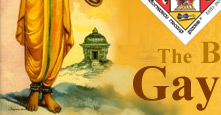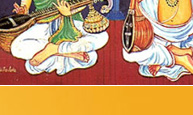 |
1.Birth
On the 5 th day 0f August 1905, The Bangalore Gayana Samaja took its birth. Thanks to the foresight of the founding members and today it stands as the oldest Institution of its type, in our Country. That an Institution serving the cause of classical music, has withstood the test of time for such a long period, is enough testimony for its innate strength and its capacity to mould and refine public taste, in this part of our country.
The prime sponsor for the birth of our Samamja, is one Sri. K. Ramachandra Rao, Head Master of the then London Mission High School, who worked as its first Honorary Secretary. The other founder members included Messrs T.Lakshminarasimha Rao, V.Subrahmanya Shastry, B.G.Shama rao, V.S.Ramaiah, K.Vasudeva Rao, D.Raghavachar, T.Venkatasubbaiah, D.Raja Rao, K.Hari Rao, N.Subba Rao, N.V.Kuppu Rao, K.S.Krishna Iyer, and others. Pradhanashiromani T.Ananda Rao, Dewan of Mysore and Rajadharmapraveena, Dewan Bahadhur Sri. K.S.Chandrashekara Iyer, Chief Justice of Mysore, was some of the erstwhile members of the Samaja. |
2.Office and Venue of Concerts
In the initial stages, the concerts used to be held in the Ekambara Sahuji Hall in Chickpet or in the Hall of the London Mission High School. In the early twenties the venue was shifted to old Sanskrit College Building. In those days the Samaja Office was functioning in a rented building at 177, 3 rd Main, Chamarajapet. The monthly rent for the Office Premises was Rs.2/-.
The narrow tile roofed hall of the Sanskrit College possessed good acoustical properties. It would be interesting to mention that a kind of "Purdah" was used in those days for seating the lady members in the audience. They used to sit behind the platform with a translucent screen between them and the platform. By way of return for the kindness with which the authorities of the Sanskrit College accommodated our concerts, it was the practice of the Samaja to arrange every year a free music concert on the occasion of their Ganapathi Pooja Celebrations.
In 1926 the Sanskrit Collage hall had to be demolished to build the present Vani Vilas Hospital and so we had to change the venue. Consequently, the activities were shifted to Shankaraiah Hall, which was constructed for this noble cause by Chief Justice Sri.K.S. Chandrashekara Iyer. We must remember with gratitude, that it is this hall that served the Samaja for a long period of 36 years and saw the Samaja through its years of struggle and the late period of stabilization till the Samaja could build its own Auditorium on K.R.Road. From 1962 and onwards we are conducting our activities in the present building.
Some of our old members, who had heard concerts both in Sanskrit Collage Hall and Shankaraiah Hall, nostalgically put on record the glory of the concerts, which were mike less and were conducted in perfect natural acoustic conditions in these two halls.
3.Samaja Building
As early as in the year 1910, the then Managing committee started making earnest attempts for getting a suitable site for the construction of a building for the Samaja. From then onwards several efforts were made in that direction. In 1931 the then City Muncipality offered a site in front of the Mahila Seva Samaja for only Rs.2,500/-, but, it did not materialize. The Samaja made several requests to the concerned for providing a suitable alternate site next to Theosophical Society. In 1941, when Samaja approached the then Deewan of Mysore, Sri. N. Madhava Rao for the grant of free site, he asked the Samaja to provide proof for arranging funds for construction of the Building. Ultimately when the Samaja could mop up a fund of Rs.30, 000/- by 1946, The State Government instructed the Muncipality to allot a suitable site free of cost. Finally, Vide Government order No,L.14120-2-ML-107-48-46 dated 3.6.1949. A site measuring 1680 sq yards was allotted in New Kalasipalyam Layout. Though, the Samaja was not happy about the area in which the site was allotted, not withstanding the right to approach the Government for more suitable place , the possession of the site was taken. Meanwhile, the Raghunatha Rao's Charities were made to agree for selling the present place having an area of around 1350Sq yards for a considered amount of Rs. 16,000/-. The Muncipality was pursued to assist financially in lieu of the allotted site. An amount of Rs.12,000/- was released by the Muncipality and the rest was made good from own funds. Thus, the ambition of having Samaja's own place was fulfilled.
The site on which the present building stands now, measures 150ft by 80ft. The building consists of a main stage of 35ft by 25ft. Side wings of 6ft wide, apron and two green rooms on either side. The auditorium measures75ft by 50ft, with side verandahs, community closets, front lobby, balcony and space for Office. The building was constructed in stages. The Stage, Auditorium and the verandah was constructed in the first stage. The front foyer was added in the second stage. In the third stage balcony was added with a seating capacity of 200, besides the caretaker's quarters above the stage. In the final stage balcony was extended to the foyer and the front elevation was provided.
The total construction cost came to Rs. 2,60,000/- inclusive of the site cost of Rs.16,000/-. The fund was realized as follows.
Vice patron's fee |
19,000/- |
| M.S.Subbalakshmi's benefit concert |
40,000/- |
| City Muncipality donation |
12,000/- |
| Souvenir Advertisements |
45,000/- |
Donations; M.L.Vasantha Kumari,C.V.Natarajan & N.Nagaranga Rao |
300/- |
| Government Of India; Matching grant |
75,000/- |
| Samaja savings |
69,700/- |
| Total |
2,61,000/- |
Sri.S.M.Ramakrishna Rao and Sri.V.T.Srinivasan as presidents, had toiled hard to realize the dream of having Samaja's own building. Sri.C.N.Shama Rao, Secretary, was responsible to get the site for the Samaja. Sri.B.Singa Iyengar, Retired Executive Engineer of Government of Mysore, prepared the blueprint , Sri.K.Padmanabhan, Executive Engineer, Government of Mysore, was the Engineering Consultant, during the first stage of the construction, while, Sri. S.Suryanarayana Setty, took over the responsibility from second stage and onwards.
4.Membership
The total intake of members was initially fixed at 100, however it was increased to 250.The monthly subscription was 4 annas only.(present 25paise or 1/4 th of a rupee.) some members volunteered to pay 8 annas, however there was no class distinction between the members. Later on the membership was categorized.
5.Subscription
Life membership subscription initially started from Rs.100/- in 1940, It was gradually increased and it was Rs.350/- during eighties. Similarly Vice-Patron ship started at Rs.500/- and was revised to Rs.1000/- for the same period. There were only two patrons, namely His Highness Sri.Krishnaraja Wadiyar and His Highness Sri.Jayachamaraja Wadiyar.
6.Management
From inception till 1957, The Managing Committee consisted of eight elected members who were electing three Office Bearers, viz., Secretary, Joint Secretary and Treasurer. It is worth while to remember these stalwarts.
Secretaries
1.K.Ramachandra Rao
2.K.Vasudeva Rao
3.T.K.Someshwara Iyer
4.Dr.C.V.Natarajan
5.B.Venkatakrishnappa
6.V.T.Srinivasan
7.C.N.Shama Rao
8.K.Natarajan
Joint Secretaries
1.K.Vasudeva Rao
2.V.S.Dixit
3.K.S.Ramaswamy
4.S.V.Srinivasan
5.B.V.Balaji
6.N.Nagaraja Rao
7.C.K.Venkataramaiah
8.K.Srinivas Iyengar
Treasurers
1.V.Subrahmanya Shastri
2.M.A.Narasimhachar
3.D.Ramaswamy Iyengar
4.M.Singarachari
In 1957, provision was made to include an elected President and an elected Vice-President, raising the managing committee strength to ten. Sri.S.M.Ramakrishna Rao, held the office of the President from 1957 to 1972, Sri.V.Krishnamurthy continued till 1977, while Sri.V.T.Srinivasan took over in 1978.
Besides, Sri.V.T.Srinivasan, Sri.C.D.Gopal Iyengar, Sri.H.R.Guruva Reddy, Sri.K.Srinivas Iyengar, Dr.R.S.Padmanabhan, Sri.A.Anantha Krishnan, Sri.R.V.Prabhakar Rao and Sri.N.Nagaraja Rao, held the Office of the Vice-President from 1957 till 1980.
7.Music Competitions
In 1951, Sri.V.T.Srinivasan, the then Hon Secretary of the Samaja was transferred to Madras as Accountant General. Samaja had organized a Farewell function. Members had liberally made contributions for this specific purpose. After the farewell ceremony, Samaja had a surplus of Rs.540/-. It was then decided to have an endowment, and the interest derived from this was used to provide prize to the winners of the proposed music competition. Thus, came the practice of conducting Annual Music Competition.
8.Music Conference
The Annual Music Conference, was started in the year 1969. Besides, concerts of Senior artists and upcoming artists, technical sessions were held in the morning/afternoon session. A senior artist was being selected to preside over different sessions, during the entire duration of the Conference. During the Valedictory of the Conference, the President of the Conference was confired the title "Snageetha Kalarathna".
9.Remunaration
It is more interesting to mention the quantum of remuneration paid to the artists. In 1912, Veena Seshanna's concert costed Rs.60/- including accompaniments. In 1919, Sri.Bidaram Krishnappa performed for Rs.75, Sri.Palghat Anantharama Bhagavathar, was paid Rs.200/- for two days programme, one music concert and one Harikatha. |









